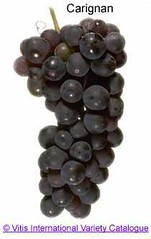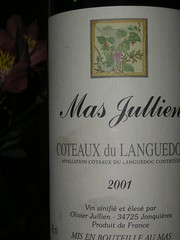
New Languedoc, Old Carignan and Deep Purple
It is home to over one third of all vines planted in France. Yet, how the Languedoc adjusts to world glut in grapes will have a profound effect on its future. Once responsible for massive amounts of low quality grapes, growers in the France’s south have had to make a choice as competition from other countries have made this a less viable business.
Faced with the option of simply pulling out vines, a new generation of winemakers have chosen to make higher quality wines. While lower yields have improved the wines, putting more emphasis on more marketable grapes like Syrah and Grenache have no doubt made them more attractive to today’s varietal conscious consumer. However, this second decision has come at a price.
The Carignan grape, indigenous to the south, has suffered as many growers have switched to Syrah and Grenache. Carignan can do wonderful things if given the opportunity, adding color, structure, depth, as well as dark cooked fruits, licorice and earthy aromas. However, since it is often relegated to the more fertile plateaus where it over produces, it can become rather innocuous.
At a recent tasting of Languedoc wines, the bottles that had appreciable levels of well-grown carignan were the ones that stood out. If you place a value on the importance of regional ‘distinctiveness,’ look for those Languedoc wines with higher percentages of this grape.

Coteaux du Languedoc 2001, Mas Jullien
One of my favourite producers is Olivier Jullien. His estate, Mas Jullien, is spread out over 15 acres around the village of Jonquiers, just north of the Mediterrean coast and the city of Montpellier. I have already reviewed his Mas Jullien Blanc, a six grapes blend that includes Grenache Blanc, Viogner and Chenin Blanc, and to my taste is one of the most distinctive and interesting whites in France that requires years of cellaring to reach it’s apogee.
His red, a blend of Carignan, Syrah and Mourvedre, is no less interesting. Like many carignan based wines, it requires a couple of years of cellaring to iron out some of the rougher edges, but it rewards patience like fe
 w wines from the region. This was my fourth bottle (I still have two left).
w wines from the region. This was my fourth bottle (I still have two left).Drunk to the tune of a big juicy steak.
Deep purple in both color and style. Like Richie Blackmore’s guitar playing, Jullien combines virtuosity with power, beauty without being very pretty. It smells and tastes of dark plums, marinated in licorice and sweet spices. Rich and concentrated, the tannins melted away to a dense, powerful and harmonious finish. This is not the new dulcimer Blackmore, but the Richie of Old.
5 comments:
Richie Blackmore I do not know however Coteaux de Languedoc -- know it and love it! And a Languedoc 2001? We're best buds, I tell you.
So how come I can't get a price on this Mas Jullien? Where can one find it?
my favorite wine in the whole world is a languedoc
its the 2003 Mas au Schiste from Domaine Rimbert
around my house we call it the bunny wine for the weird, angly hare on the label
it's redolent of roses and green chiles and undeniably delicious!
i'll have to find this one too...
So marcus, get with your old "Deep Purple" self...
and i hope that you can find it Ann,it's greeeaaaat!
Bill
Spooky - I was at a Languedoc tasting this week and couldn't resist describing several as 'deep purple'.
Bill:
Word verification should take care of the spammers, not sure how they're getting through?
You need to post more, dude. Get back on that horse....
Cheers,
V
Post a Comment